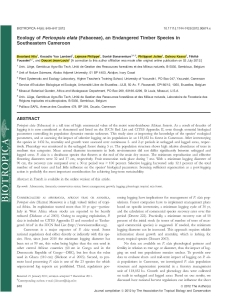Bourland N, Kouadio YL, Lejeune P, Bonnaventure S, Philippart J, Daïnou K, Fétéké FR, Doucet JL.
Dans cet article, les auteurs présentent l’écologie de l’assaméla (Pericopsis elata). En tant qu’espèce inscrite sur la liste rouge CITES de l’IUCN, des solutions de gestion de la ressources sont proposées.
Résumé EN. Pericopsis elata (Fabaceae) is a tall tree of high commercial value of the moist semi-deciduous African forests. As a result of logging which started decades ago, it is considered as threatened and included on both IUCN Red List and CITES Appendix II even though essential biological parameters controlling its population dynamics remain unknown. This study aims at improving the knowledge of the species ecological parameters and at assessing the impact of selective logging on its populations in an 118,052 ha forest in Cameroon. After inventorying the species in 1,432 ha, mortality and growth were assessed over continuous 5- and 2-year periods in unlogged and logged areas, respectively. Phenology was monitored in the unlogged forest during 5 years. The population structure followed a bell-shaped curve. Mean annual diameter increments in both environments did not differ significantly between unlogged and logged areas. P. elata is a deciduous species that flowers at the end of the main dry season. The minimum reproduction and effective flowering diameters were, respectively, 32 and 37 cm. Fruit maturation took place during 7 months. With a minimum logging diameter of 90 cm, the recovery rate computed over a 30-year period was greater than 100%. Selective logging harvested only 12.1% of the total number of seed trees and had little influence on the species biological parameters. Securing sufficient regeneration as a post-logging action is probably the most important consideration for achieving long-term sustainability. Implications for the conservation status of the species are discussed at the regional level.
Consultez la notice complète de l’article sur ORBi

